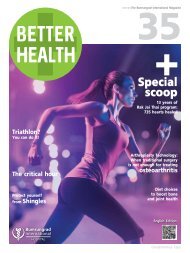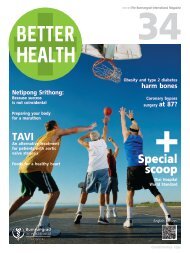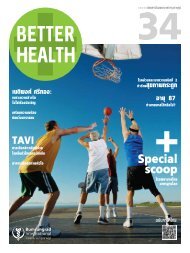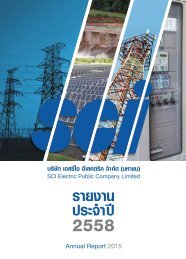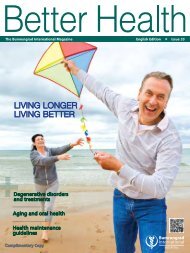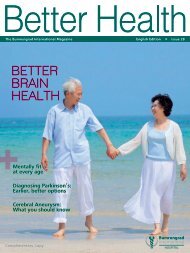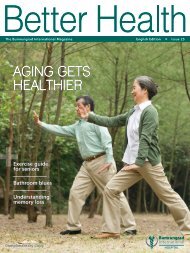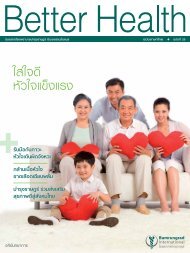Better Health 13 ENG
The magazine for patients and friends of Bumrungrad International Hospital, Thailand.
The magazine for patients and friends of Bumrungrad International Hospital, Thailand.
- TAGS
- hopital
- thailand
- bumrungrad
You also want an ePaper? Increase the reach of your titles
YUMPU automatically turns print PDFs into web optimized ePapers that Google loves.
W e l c o m e<br />
04<br />
W<br />
elcome to <strong>Better</strong> <strong>Health</strong>, the magazine <br />
for patients and friends of Bumrungrad<br />
International. <br />
<br />
There are countless differences between men<br />
and women, and issues of health and medical care<br />
are no exception. In this issue, we're devoting special<br />
attention to the important health topics affecting men. <br />
For decades the term menopause has been used<br />
to describe the unique changes women experience<br />
beginning around the age of 40. Our cover story<br />
beginning on page four explores andropause a<br />
more recent and lesser known concept that describes<br />
the changes that occur in men age 40 and above.<br />
We examine the nature of these changes, and how<br />
the medical community is bringing greater knowledge<br />
and advances in treating age-related problems in men. <br />
Prostate problems such as cancer, prostatitis<br />
and prostate enlargement are among the most common<br />
ailments in men over 40. Our story beginning on<br />
page 12 provides an overview of their causes and<br />
treatment options, while our feature on page 15 reports<br />
on an exciting new treatment called HDR Brachytherapy,<br />
which has already brought many patients at<br />
Bumrungrad and around the world successful<br />
treatment outcomes for prostate problems.<br />
Finally, we devote our Q & A feature on page 10<br />
to the subject of erectile dysfunction (ED). We turned<br />
to a leading ED expert to answer the important<br />
questions men have about dealing with this<br />
sensitive and treatable problem.<br />
As always, we welcome your feedback, ideas<br />
and comments about <strong>Better</strong> <strong>Health</strong>. Please feel free<br />
to e-mail us at betterhealth@bumrungrad.com.<br />
We look forward to hearing from you, and<br />
here's wishing you better health.<br />
<br />
<br />
<br />
Oranuch Nilpradit<br />
Contributing Editor<br />
Contact Bumrungrad International <br />
Telephone: 66 (0) 2667 1000<br />
Facsimile: 66 (0) 2667 2525<br />
Out-patient<br />
appointment: 66 (0) 2667 1555<br />
Website: www.bumrungrad.com<br />
<br />
<strong>Better</strong><strong>Health</strong><br />
<strong>Better</strong> <strong>Health</strong> magazine is published quarterly by Bumrungrad<br />
Hospital Public Company Limited and is produced for Bumrungrad<br />
Hospital Public Company Limited by Oakins and Stone Limited,<br />
Suite 2-A, Asoke Court, 16 Sukhumvit 21 Road (Asoke), Klongtoey-nua,<br />
Wattana, Bangkok 10110 Tel: +66 (0) 2261 1211 Fax: +66 (0) 2261 12<strong>13</strong>.<br />
No part of this magazine may be reproduced without the written<br />
permission of Bumrungrad Hospital Public Company Limited.<br />
All rights reserved. c 2008 by Bumrungrad Hospital Public<br />
Company Limited. <br />
C o n t e n t s<br />
04 Andropause: Understanding and Treating<br />
Men’s Mid-life <strong>Health</strong> Problems<br />
<br />
10 Q & A: Erectile Dysfunction<br />
<br />
12 A Protective Approach to Prostate <strong>Health</strong><br />
<br />
15 HDR Brachytherapy _ An Effective Alternative<br />
for Treating Prostate Cancer<br />
<br />
16 <strong>Health</strong> Briefs<br />
<br />
18 News from Bumrungrad International<br />
<br />
<br />
<br />
12 15 18
A N D R O P A U S E <br />
Andropause: Understanding<br />
and Treating Men’s Mid-life<br />
<strong>Health</strong> Problems<br />
For men over 40, getting older doesn’t have to mean living with<br />
declining health. Thanks to extensive research and new treatment<br />
advances, male andropause can be diagnosed and treated<br />
successfully.<br />
T<br />
here’s a ring of truth to the old saying that “Life begins<br />
at 40.” Entering the middle part of life is supposed<br />
to be a positive experience, and a time to feel more<br />
settled, established and comfortable. <br />
But for a great number of men, life beyond the age of<br />
40 can feel more like the end of good health, with<br />
unexplained fatigue, insomnia, depressed feelings and a<br />
general lack of enthusiasm for living not unlike the<br />
difficulties many women encounter during menopause. For<br />
some middle-aged men, the physical and mental toll of<br />
everyday living means a profound decline in quality of life. <br />
Given the similarities to the symptoms of female<br />
menopause, this condition has been referred to as “male<br />
menopause” or “mid-life crisis.” Some used to believe it was<br />
just a normal part of the male aging process. Others<br />
questioned whether it was all just a state of mind. <br />
So what exactly is it that these men are experiencing?<br />
And what is the best way to deal with it? For answers,<br />
<strong>Better</strong> <strong>Health</strong> turned to Dr. Pansak <br />
Sugkraruek, an endocrinologist and fertility<br />
expert with vast experience treating men<br />
for what is now called andropause. <br />
<br />
WHAT IS ANDROPAUSE? <br />
Years ago many doctors believed that male<br />
‘menopause’ symptoms were merely an unavoidable part of<br />
the aging process; consequently, relatively little research effort<br />
was made to understand what exactly was causing the condition.<br />
Thanks to intensive research in recent years, science now has a<br />
clear understanding that andropause results from declining levels<br />
of several male hormones. <br />
“People used to equate these symptoms in men with those<br />
that occur during female menopause, and so the term ‘male<br />
menopause’ was coined,” says Dr. Pansak. “Extensive research in<br />
recent years has shown that the term doesn’t properly describe the<br />
male condition. While the symptoms are similar in both men and<br />
women, the causes are very different.” <br />
For women, menopause begins when the ovaries stop<br />
functioning and no longer produce hormones. “In men, hormone<br />
production continues,” Dr. Pansak explains, “but certain bodily<br />
conditions impair a man’s hormone production to such an extent<br />
that this hormone deficiency begins to have a noticeable effect on<br />
some important body functions.”<br />
“The correct term to describe this process is testosterone<br />
deficiency syndrome or androgen deficiency of the aging male,”<br />
says Dr. Pansak. “In simple terms, this is andropause.”<br />
<br />
ANDROPAUSE AND HORMONE DEFICIENCY<br />
The impact of hormone deficiency in men is usually<br />
gradual and often goes unnoticed at least initially. “As the<br />
condition progresses it can lead to a significant impact in both<br />
4
physical and psychological<br />
terms on a man’s quality<br />
of life,” Dr. Pansak<br />
explains. “Andropause<br />
affects a man’s self-esteem<br />
and how he relates to<br />
others. Men with hormone<br />
deficiency often feel<br />
frustrated, irritable,<br />
subdued and pessimistic.<br />
Their muscles contract<br />
while body fat increases.<br />
They often experience<br />
insomnia, emotional<br />
turbulence, less-sharp<br />
thinking, a decreased<br />
sex drive and erectile<br />
dysfunction. Serious cases<br />
can eventually lead to<br />
clinical depression.” <br />
Andropause affects<br />
more than just testosterone. “All hormones experience a decline,”<br />
Dr. Pansak continues. “One of the first to decline is melatonin,<br />
the so-called ‘hormone of the night.’ Melatonin is normally<br />
secreted after sundown and helps a person feel sleepy as bedtime<br />
approaches, allowing y man, the pituitary gland produces a<br />
variety of hormones during deep sleep. The first of these is the<br />
growth hormone which preserves one’s youthfulness and<br />
counters the aging process.”<br />
"The thyroid gland then produces a hormone that converts<br />
food into energy,” explains Dr. Pansak. “A healthy thyroid<br />
hormone function gives a man energy to enthusiastically engage<br />
in activities. The adrenal gland produces the antioxidant<br />
hormone DHEA that slows the aging process.”<br />
The male sexual hormone testosterone is the last hormone<br />
<br />
produced. “This hormone helps one think decisively, reasonably<br />
and positively as a healthy man should,” says Dr. Pansak. “It<br />
also supports bone and muscle strength and regulates body fat<br />
and body contour. That’s why men with normal hormone levels<br />
usually don’t have a ‘beer belly.’ Their bodies are strong and<br />
their mood is good.” <br />
<br />
THE DANGERS OF MALE HORMONE<br />
DEFICIENCY<br />
If left untreated, male hormone deficiency poses a number<br />
of potentially serious health risks, including fragile bones, weak<br />
muscles, erectile dysfunction, hypertension,<br />
heart disease and stroke.<br />
“With decreased hormone levels,<br />
body fat increases and accumulates<br />
around the waistline,” notes Dr.<br />
Pansak. “The ‘beer belly’ is one<br />
sign of male hormone<br />
deficiency. The criterion is a<br />
waistline in excess of 94<br />
centimeters for westerners<br />
and 90 centimeters for<br />
easterners.”<br />
<br />
BEER BELLY<br />
DANGERS<br />
While most of us are<br />
aware of the health risks<br />
that come with being<br />
overweight, the specific<br />
dangers for men with<br />
excessive fat accumulation<br />
around the waist are less<br />
well understood, but no less serious. <br />
“Think about it: When a man has a ‘spare tire’
around his waist, he’s unlikely to have the energy or the desire to<br />
stay active,”<br />
Dr. Pansak explains. “This lack of activity means he’s not using<br />
enough energy to burn his daily calorie intake, and that leads to<br />
even more fat buildup. This increased fat clogs blood vessels and<br />
leads to hypertension. It can also cause dyslipidemia, the condition<br />
of having too much ‘bad’ cholesterol and not enough ‘good’<br />
cholesterol. This can significantly raise a man’s risk for stroke,<br />
a potentially deadly condition.” <br />
This unhealthy state can also affect a man’s sexual health.<br />
“Clogged blood vessels affect the supply of blood to the genitals,”<br />
says Dr. Pansak. “This can cause erectile dysfunction. Excess fat<br />
accumulates in the genital muscles, further worsening the<br />
symptoms. This is a prime example of how the body’s many<br />
systems are interconnected.” <br />
Dr. Pansak stresses the importance of consulting a doctor at<br />
the first sign of difficulty in achieving a normal erection. “Your<br />
doctor may recommend a hormone level test to check for possible<br />
deficiencies,” he explains. “Your doctor can recommend a<br />
treatment strategy for sexual impotency as well as other steps<br />
to address one’s overall health situation.” <br />
<br />
TREATING HORMONE DEFICIENCY<br />
Hormone Supplement Therapy<br />
The old saying “Getting old is natural, feeling old is<br />
optional” certainly applies to male hormone deficiency. Today’s<br />
modern lifestyles are far different from earlier generations.<br />
People tend to spend more time working and less time sleeping,<br />
and most of us endure greater stress from everyday living. Our<br />
fast-paced world leads to eating on-the-run and sleeping just a<br />
few hours a night, while leaving less time for exercise and<br />
relaxation. These factors all contribute to premature hormone<br />
deficiency.<br />
6<br />
Dr. Pansak shares his experience: “I see more and more<br />
men in their 30s who come to me because of loss of sexual<br />
desire and erectile dysfunction, hair loss or obesity. Dealing with<br />
their problems requires a holistic approach, to diagnose and treat<br />
the full range of health issues to produce a successful treatment<br />
outcome.” <br />
“Sexual impotency is an important indicator of male health<br />
problems, so we have to check blood sugar and body fat levels,<br />
hormone levels, the health of the prostate gland, and understand<br />
a patient’s lifestyle and family history to see what changes may<br />
be needed,” says Dr. Pansak. “Hormone supplement therapy is<br />
often recommended as part of the treatment plan. After a period<br />
of taking hormone supplements, patients usually experience<br />
noticeable improvements to their health and wellness, which are<br />
often accompanied by weight loss and improved sexual function.<br />
A patient’s mood and overall happiness usually also improves.”
Hormone supplement<br />
therapy has an impressive<br />
record of safety for<br />
effectively treating<br />
men suffering from<br />
andropause. All medical<br />
treatments and<br />
procedures involve<br />
some level of risk<br />
and may not be<br />
suitable for everyone.<br />
Your doctor will<br />
explain the risks<br />
involved and<br />
recommend the<br />
course of treatment<br />
that’s right for your<br />
individual situation. <br />
<br />
Lifestyle Modification<br />
Dr. Pansak emphasizes the hormone-related differences<br />
between men and women. “The female body stops producing<br />
female hormones during menopause,” he explains. “Replacement<br />
therapy is usually recommended to mitigate the negative effects.<br />
On the contrary, the male body never stops producing male<br />
hormones. The levels of hormones decline, but they can be<br />
restored. Doctors will advise their patients on specific lifestyle<br />
changes that can help increase hormone production. For some<br />
patients usually older men with greater hormone deficiency<br />
doctors will also prescribe male hormone supplements to be<br />
taken on a regular basis.” <br />
There are simple guidelines that all men can follow to<br />
improve their overall health and limit the effects of hormone<br />
deficiency. Dr. Pansak recommends: <br />
going to bed early enough to ensure that you fall into deep<br />
sleep by midnight;<br />
exercising most days for 45 minutes per workout (or 300<br />
total minutes each week) as opposed to the 30 minutes-perworkout<br />
guideline for the general population;<br />
eating a healthier diet;<br />
adopting a positive attitude in order to avoid depression<br />
and insomnia.<br />
According to Dr. Pansak, unhealthy living is often the<br />
biggest single factor in causing male hormone deficiency. So<br />
making healthy lifestyle changes under the supervision of a<br />
medical specialist can prove highly effective in returning to<br />
better health. Middle age really can be the beginning of a<br />
happier, healthier life. As the famous comedian George Burns<br />
said, “You can’t help getting older, but you don’t have to<br />
get old.”<br />
Do you have hormone<br />
deficiency? Find out by<br />
taking this quiz. <br />
Are you experiencing these symptoms?<br />
<br />
<br />
Sexual health:<br />
Yes<br />
1. Decreased sex drive<br />
2. Difficulty achieving and/or<br />
maintaining an erection<br />
<br />
General health:<br />
3. Decreased strength and stamina<br />
4. Fatigue or lack of energy<br />
5. Depression<br />
6. 'Shrinking' or having a hunched back<br />
7. Difficulty concentrating at work <br />
8. Feeling unhappy or pessimistic about life <br />
9. Decreased athletic capabilities<br />
10. Falling asleep or nodding off<br />
during the day<br />
<br />
<br />
If you answered YES to questions 1 or 2, or if you<br />
answered YES to at least 3 of the general health questions,<br />
you may be experiencing male hormone deficiency. Consult<br />
your doctor for a physical examination and a hormone level<br />
test.<br />
No<br />
<br />
<br />
<br />
8
Q & A<br />
In survey after survey, men report that<br />
declining sexual performance is one of their<br />
greatest fears about getting older. As part<br />
of our focus on men’s health issues, <strong>Better</strong> <strong>Health</strong><br />
answers some important questions from readers<br />
about erectile dysfunction (ED).<br />
Q: What are the most common myths and misconceptions<br />
about ED? <br />
<br />
A: One common misconception is that emotional and<br />
psychological problems are the<br />
main causes. In truth, it’s just the<br />
opposite; research has shown that<br />
physical causes account for over<br />
80% of ED cases. <br />
Another popular myth is that<br />
ED is an unavoidable part of the<br />
aging process. Yes, a man’s hormone<br />
levels diminish with age, and he<br />
may need more stimulation to<br />
achieve a healthy erection. But age alone does not cause ED. <br />
<br />
<br />
Q: What are the most common causes of ED? What are the<br />
key risk factors?<br />
<br />
A: Difficulty achieving an erection can be caused by any number<br />
of factors, either physical, psychological, or a combination of the<br />
two. A number of medical conditions are known to cause ED,<br />
including some arterosclerosis, heart and vascular diseases,<br />
diabetes, prostate conditions including enlargement and cancer,<br />
diseases affecting the nerves and brain (e.g. multiple sclerosis,<br />
Parkinson’s disease, Alzheimer’s disease), and vascular conditions<br />
that affect blood vessels and circulation.<br />
Unhealthy living excessive stress, obesity and poor<br />
nutrition, lack of exercise, tobacco use, excessive alcohol<br />
consumption and drug use, among others can lead to ED. It’s<br />
also a potential side effect resulting from a number of prescription<br />
medications, medical procedures and surgeries. <br />
Age also plays a role; studies show ED affects about one<br />
out of 20 men aged 40, but about one out of four men aged 65.<br />
ED can also be a symptom of a potential undiagnosed<br />
medical condition; which is one of many reasons why it is<br />
important for men to talk to their doctor about ED.<br />
<br />
Q: What treatment options are most effective?<br />
<br />
A: There has been tremendous progress in the number and<br />
effectiveness of treatments for ED. The best treatments include<br />
medications (taken orally), penile implants, and penile pumps.<br />
Doctors often recommend lifestyle modifications such as exercise,<br />
smoking cessation, and stress reduction, all of which help<br />
improve erectile function and overall health.<br />
<br />
Q: What advice should be<br />
given to men who may be<br />
suffering from ED but are<br />
reluctant to seek help?<br />
<br />
A: Men should know that<br />
it’s normal to feel anxious<br />
about talking to your doctor<br />
about ED. Men have always<br />
been less likely than women<br />
to make regular doctor visits, and there’s a stigma in almost<br />
every society that men should be able to handle their problems<br />
by themselves, and that feeling vulnerable or seeking help is a<br />
sign of weakness. <br />
Doctors have been successfully treating men with ED for<br />
many years. With even more effective treatment options available<br />
now, whatever anxiety men may feel about seeking help always<br />
pales in comparison to the anxiety and potentially serious<br />
medical problems that can result from not seeking help.<br />
10<br />
Have a question? You can submit your question for possible inclusion in future issues of <strong>Better</strong> <strong>Health</strong>, by e-mail<br />
betterhealth@bumrungrad.com or by mail to Editor, <strong>Better</strong> <strong>Health</strong> Magazine, Bumrungrad International, 33 Sukhumvit 3, <br />
Wattana, Bangkok 10110 Thailand.<br />
In the next issue: The next issue of <strong>Better</strong> <strong>Health</strong> will be published in October. Be sure to submit any questions<br />
>>for possible inclusion no later than September 25, 2008.
P R O S T A T E H E A L T H <br />
A Proactive Approach<br />
to Prostate <strong>Health</strong><br />
As a man enters middle age, his risk of developing prostate problems increases significantly.<br />
Following is a look at what every man should know about potentially serious prostate conditions,<br />
and the proactive steps that can be taken to reduce your own risk. <br />
M<br />
en and women are different when it comes to matters<br />
of health. Though the aging process increases the risk<br />
of health problems for both men and women, male<br />
life expectancy remains several years shorter, and men remain<br />
less likely to see a doctor for regular check-ups or when health<br />
problems arise.<br />
With the help of Dr. Apichart Kongkanan, a board-certified<br />
urologist with vast experience treating men with prostate conditions,<br />
<strong>Better</strong> <strong>Health</strong> looks at the important issues every man should<br />
understand about prostate health. <br />
<br />
THE PROSTATE’S IMPORTANT ROLE<br />
The prostate is the walnut-size reproductive gland located<br />
below a man’s bladder that plays an important role in sexual<br />
health and reproduction. During ejaculation, the prostate gland<br />
produces whitish seminal fluid that protects sperm produced by<br />
the testicles. Unlike other organs and glands, the prostate doesn’t<br />
stop growing in early adulthood.<br />
“Normally, body organs reach full size after a man’s<br />
transition from adolescence to adulthood around his early 20s,”<br />
Dr. Apichart explains. “However, the prostate continues to grow.”<br />
Just how much it<br />
Beginning at age 40,<br />
men should have<br />
regular annual<br />
prostate check-ups<br />
grows depends<br />
on the level of<br />
testosterone, the<br />
male sex hormone<br />
which usually<br />
declines as a man<br />
ages. <br />
Declining<br />
testosterone levels<br />
can lead to an unhealthy enlargement of the prostate gland the<br />
less testosterone sent to the prostate, the more the enzymes in<br />
the prostate convert testosterone to Dihydrotestosterone (DHT),<br />
which is the hormone responsible for prostate enlargement and<br />
cause one or more prostate diseases. <br />
<br />
CANCER AND OTHER PROSTATE DISEASES<br />
When the prostate becomes enlarged, it may begin pressing<br />
against the urethra, leading to urinary control problems, painful<br />
or uncomfortable urination, and/or the presence of blood during<br />
urination. In serious cases, cancerous tumors may begin to form<br />
in the prostate, and if left untreated, the cancer may spread to<br />
12<br />
other areas of the body. In most parts of the world, prostate<br />
cancer is the leading type of cancer among men. <br />
Men should see their doctor at the first sign of abnormal<br />
urinary function as this may be a symptom of one or more of<br />
the following prostate conditions: <br />
<br />
Prostatitis<br />
The term prostatitis means inflammation of the prostate<br />
gland. It is often found in men between the ages of 30 to 50 and<br />
can result from both bacterial and non-bacterial causes. Prostatitis<br />
is not considered contagious.<br />
Bacterial prostatitis is usually the result of bacteria entering<br />
the prostate through the urinary tract. Typical symptoms include
fever, chills, muscle aches, pain in the penis and/or testicles, and<br />
abnormal urination. <br />
The symptoms of non-bacterial prostatitis are similar to<br />
those of bacterial prostatitis but the source of the infection may<br />
be difficult to identify. <br />
<br />
Prostate Enlargement (Benign Prostate Hypertrophy)<br />
This condition typically affects men beyond the age of 40<br />
who have reduced levels of testosterone. Patients usually fall into<br />
one of two groups based on whether they show obstructive or<br />
irritative symptoms. Obstructive symptoms include weak or<br />
intermittent urinary stream, hesitation before urine flow begins,<br />
or a feeling that the bladder has not emptied completely. Irritative<br />
symptoms include an increased frequency of urination, urgent<br />
need to urinate, and bladder pain or irritation while urinating. <br />
Prostate enlargement is usually not life threatening, but its<br />
symptoms can have a major impact on a man’s quality of life.<br />
Prostate enlargement may lead to kidney problems including<br />
kidney stones and further loss of bladder control.<br />
Patients with mild<br />
symptoms are usually<br />
treated through<br />
a combination of<br />
lifestyle changes and<br />
medication. Doctors<br />
often recommend<br />
reducing liquid<br />
consumption<br />
in the evening<br />
hours, cutting<br />
back on alcoholic<br />
and caffeinated<br />
beverages, and<br />
avoiding medications<br />
such as decongestants<br />
which can increase the desire to urinate. A number of prescription<br />
medications have been proven safe and effective in treating<br />
overactive bladders. <br />
<br />
Prostate Cancer<br />
Prostate cancer occurs when cancerous cells within the<br />
prostate grow and divide abnormally to form malignant tumors.<br />
Age and family history are key risk factors in developing prostate<br />
cancer; a man’s risk increases significantly after the age of 40,<br />
and having a father or brother who has had prostate cancer<br />
increases a man’s own prostate cancer risk. <br />
Prostate cancer especially when detected early is<br />
treatable and curable. As the cancer cells grow and press against<br />
the urethra, they typically produce symptoms such as frequent<br />
urination, difficulty or pain during urination, or the presence of<br />
blood in the urine. In serious cases, the cancer eventually spreads<br />
to the lymph nodes, bones or other organs where it becomes<br />
difficult to treat and impossible to cure.<br />
PREVENTING<br />
PROSTATE PROBLEMS <br />
As with so many other<br />
medical problems, prevention<br />
and early detection are the<br />
most important steps a man<br />
can take to avoid prostate<br />
problems. “Beginning at the<br />
age of 40, men should have<br />
regular annual prostate<br />
check-ups, because prostate<br />
cancer in its early stage is<br />
highly treatable, but it may<br />
not cause any symptoms,”<br />
Dr. Apichart says. “Moreover,<br />
men should see their doctor<br />
immediately if they encounter any<br />
urinary problems don’t wait until your next check-up!” <br />
Good nutrition habits can lower one’s risk of developing<br />
prostate problems. “Cooking with oils like olive oil and peanut<br />
oil, which are high in monounsaturated fats, can promote prostate<br />
health,” Dr. Apichart says. “Other healthy choices include eating<br />
fish like mackerel and salmon that are rich in cancer-fighting<br />
omega-3 fatty acids. Vegetables containing Allyn Sulfur,<br />
including garlic, onions, chive and soy protein, have been found<br />
to have cancer-fighting properties. And avoid high fat foods as<br />
they can increase one’s risk of prostate cancer and other serious<br />
conditions.” <br />
“The key to good prostate health is to maintain good overall<br />
health, and pay attention to signs of potential prostate problems,<br />
especially urinary tract symptoms,” Dr. Apichart recommends.<br />
“And get in the habit of regular doctor visits, because preventing<br />
illness is always easier than treating it.”<br />
How is prostate cancer<br />
diagnosed?<br />
Digital Rectal Exam (DRE) the doctor places a finger<br />
inside the rectum to check for changes to the size and<br />
surface of the prostate.<br />
<br />
PSA (prostate-specific antigen) Test this blood test<br />
measures the level of a naturally-occurring protein<br />
produced by the prostate. High or increasing levels can<br />
indicate the presence of prostate cancer. <br />
<br />
Ultrasound the prostate can be examined through a<br />
type of ultrasound called transrectal ultrasonography. A<br />
tube inserted into the rectum transmits sound waves to<br />
the nearby prostate, producing a computerized image.<br />
<br />
Biopsy if diagnostic tests and symptoms suggest<br />
prostate cancer, the doctor will perform a prostate<br />
biopsy, a technique in which a small sample of tissue is<br />
removed through a tiny needle and examined under a<br />
microscope to check if the cells are malignant.<br />
<br />
<strong>13</strong>
PET CT <br />
New Innovation = Earlier, More Precise Cancer Detection<br />
very year, cancer claims the lives of millions of<br />
people. It continues to be a leading cause of death<br />
among Thais. But it doesn’t have to be that way. Many<br />
types of cancer are treatable and curable if detected early. <br />
<br />
Recent advances in<br />
technology are helping detect<br />
cancerous cells earlier and<br />
with greater precision and<br />
accuracy, making it possible<br />
to save potentially millions of<br />
lives. One of the most exciting<br />
innovations in cancer detection<br />
is PET/CT (Positron Emission<br />
Tomography / Computed<br />
Tomography) technology. In<br />
the few short years since its<br />
introduction, PET/CT has<br />
become one of the most highly<br />
effective tools for early detection<br />
of cancerous cells. <br />
<br />
PET/CT provides an<br />
anatomical map of the body<br />
with 64 slices per revolution in<br />
only 0.33 seconds. It produces<br />
high resolution 2-dimensional<br />
and 3-dimensional images<br />
capable of revealing even tiny<br />
traces of cancerous tissue - as<br />
small as 3 millimeters in size. Its effectiveness helps doctors<br />
to plan medical treatments and schedule suitable to each<br />
patient individually.<br />
Dr. Narongsak Kiatikajornthada, Hematology and<br />
Oncology specialist at Bumrungrad International Hospital,<br />
explains how PET/CT technology is used to pinpoint the<br />
exact location and size of tumors and to quickly determine<br />
the exact stage of cancer. “The procedure begins with an<br />
injection of FDG, an analog<br />
of glucose that is tagged<br />
to the radionuclide F18,”<br />
Dr. Narongsak says. “Tumors<br />
trap more FDG than other<br />
organs, so PET/CT can identify<br />
gamma rays in the rapidly<br />
growing tumors. This helps<br />
doctors to detect and diagnose<br />
cancer faster and easier.”<br />
<br />
The scanner pinpoints the<br />
exact location of tumors that<br />
may have gone unnoticed by<br />
other CT or MRI diagnostic<br />
tools. Besides cancer, PET/<br />
CT can also detect some<br />
brain diseases such as<br />
Alzheimer’s disease and<br />
epilepsy.<br />
<br />
With early detection being<br />
among the most important<br />
factors for successful cancer<br />
treatment, Bumrungrad<br />
patients are already reaping significant benefits through<br />
more successful and less traumatic treatment regimens.<br />
<br />
<br />
14
H D R B R A C H Y T H E R A P Y <br />
HDR Brachytherapy –<br />
An Effective Alternative<br />
for Treating Prostate Cancer<br />
Learn more about this revolutionary way of utilizing<br />
radioactive materials to combat localized cancer.<br />
P<br />
rostate cancer is the most common cancer among men <br />
worldwide, and according to Thailand’s National Cancer <br />
Institute, it is the ninth leading cause of death among <br />
Thai men. There are several ways to treat prostate cancer,<br />
depending on the stage of the disease and the patient’s symptoms.<br />
Widely-used treatments include surgery, chemotherapy and<br />
external-beam radiation therapy. Among the newer and most<br />
exciting treatment advances is High Dose Rate (HDR)<br />
Brachytherapy, which uses radioactive seed implants to shrink<br />
prostate cancer tumors with better treatment outcomes and fewer<br />
complications than earlier generation radiation treatments. <br />
<br />
RADIOACTIVE SEED IMPLANTS<br />
Radioactive seed implantation is an increasingly popular<br />
choice for treating and curing prostate and other types of cancer.<br />
“Implanting radioactive seeds is one of the minimally-invasive<br />
techniques that is suitable for patients whose cancer is still<br />
localized within the prostate gland,” says Radiotherapist<br />
Dr. Apichart Panichchivaluck. <br />
During the implantation procedure, the doctor first<br />
measures the volume of the patient’s prostate gland to properly<br />
calculate the necessary radiation dosage. Tiny radioactive seeds<br />
are then inserted through catheter tubes into the prostate gland,<br />
where they emit radiation that destroys the cancerous cells. There<br />
are two main methods of prostate brachytherapy: permanent seed<br />
implantation and high dose rate (HDR) temporary brachytherapy.<br />
“Permanent seed implantation is typically used when the<br />
prostate cancer is the low-risk localized type,” Dr. Apichart<br />
explains. “Permanent seed implants involve injecting radioactive<br />
seeds which give off radiation at a low dose rate to kill cancer<br />
cells over several weeks or months, while the seeds remain in<br />
the prostate gland permanently.”<br />
<br />
HIGH DOSE RATE (HDR) TEMPORARY<br />
BRACHYTHERAPY<br />
For patients with an intermediate or high risk localized<br />
prostate cancer, doctors usually choose high dose rate radioactive<br />
seeds (High Dose Rate Brachytherapy, also known as temporary<br />
brachytherapy). “The HDR implant employs different radiation<br />
sources than permanent seed implantation,” says Dr. Apichart.<br />
“There is also the probability for patients with prostate cancer at<br />
this stage that the cancer has spread beyond the capsule of the<br />
prostate gland. HDR temporary brachytherapy involves placing<br />
very small plastic catheters into the prostate gland. A series of<br />
radiation treatments is performed by pushing radioactive seeds<br />
into the catheter using a computer-controlled machine under<br />
Transrectal Ultrasound Guidance (TRUS). This helps control the<br />
radiation dose in different regions of the prostate. After the catheter<br />
is removed, no radioactive material is left in the prostate gland.” <br />
The ability to modify the radiation dose after the catheters<br />
are in place is one of the main advantages of temporary brachytherapy<br />
compared to permanent seed implants. HDR brachytherapy is<br />
highly effective in the treatment of intermediate to high risk<br />
localized prostate cancer, and is also useful in the control of localized<br />
recurrence. It has also been reported that HDR brachytherapy<br />
can achieve survival rates above 90% in prostate cancer patients,<br />
while the side effects such as urgency to urinate, frequent urination,<br />
and erectile dysfunction have been shown to be much lower<br />
than with other types of treatments.<br />
15
H E A L T H B R I E F S<br />
Men Still Reluctant to Get Tested<br />
for Colon Cancer <br />
Even when it’s free, men are still less likely to have a colon<br />
cancer screening test that could ultimately prove life-saving. That’s<br />
the finding of a Swedish research study whose results were<br />
reported in the International Journal of Cancer.<br />
Researchers offered free sigmoidoscopy screening tests to<br />
nearly 2,000 adults between the ages of 59 to 61 [Sigmoidoscopy is<br />
one of several screening tests that help detect the presence of colon<br />
cancer and pre-cancerous polyps]. Routine screening for colon<br />
cancer is generally recommended for adults starting at age 50, and<br />
sooner for people considered at higher risk for the disease. <br />
<br />
<br />
<br />
<br />
<br />
<br />
<br />
<br />
<br />
<br />
<br />
<br />
<br />
Men were nearly 30% more likely than women to decline the<br />
test. Differences were also found between single and married <br />
adults; unmarried or divorced men and women were much less<br />
likely to be tested compared to married adults. <br />
The results of the Swedish study were consistent with other<br />
research that also found men to be more reluctant than women to<br />
have health screening tests; men tend to be less knowledgeable<br />
about health and less likely to take preventive measures like<br />
screening tests.<br />
Exercise May be<br />
the True ‘Fountain<br />
of Youth’<br />
Aging ungracefully can<br />
mean wrinkles, weak bones and<br />
muscles, and a losing struggle to<br />
keep off unwanted extra weight. <br />
According to Dr. Pravee Sirithientas, sports medicine<br />
specialist at Vitallife Wellness Center, aging results from<br />
a decline in the body’s production of human growth<br />
hormone the naturally-occurring substance that promotes<br />
healthy cell growth. The hormone promotes smoother skin,<br />
fights body fat, and helps build muscle mass. However, the<br />
jury is still out on growth hormone therapy due to potential<br />
side effects and high cost. <br />
Exercise may be the best choice to safely slow the aging<br />
process. And even moderate exercise walking or gardening<br />
for 30 minutes can deliver impressive health benefits.<br />
Adding vitamins and nutrition supplements can further<br />
stimulate the production of human growth hormone,<br />
providing an additional boost to an anti-aging regimen. <br />
Exercise is also a great way to enhance brain function<br />
well into old age. Be sure to talk to your doctor before<br />
starting any new exercise or vitamin program.<br />
<br />
<br />
Battle of the Bulge: Number of Fat Cells may be<br />
Set Early in Life <br />
As the old saying goes, “The only thing harder than losing weight is keeping it off.” A new<br />
study on fat cells may help explain why that sentiment rings true. Scientists in Sweden studying<br />
how the number of fat cells change over time reported that the number is set during adolescence<br />
and then remains unchanged throughout adult life even after drastic weight loss. <br />
At the beginning of the study, researchers measured the number of fat cells in groups of<br />
children, adolescents and adults. They found that fat cell numbers increased throughout childhood<br />
and adolescence, but by the beginning of adulthood, the number reached its peak and remained<br />
constant. <br />
The next phase of the study measured the number of fat cells in people before and after<br />
undergoing major weight loss through a procedure called gastric banding. While the procedure<br />
can lead to weight loss in excess of 100 kilos, the study showed the number of fat cells hardly<br />
changed. <br />
The findings, first reported in the journal Nature, aren’t good news for people struggling<br />
to lose unhealthy excess weight; rather, they further reinforce the importance of developing and<br />
sticking to healthy diet and exercise habits beginning early in life.<br />
16
N E W S F R O M B U M R U N G R A D I N T E R N A T I O N A L<br />
A New Era of Care Begins at the<br />
Newly-Opened Bumrungrad<br />
International Clinic<br />
1<br />
F<br />
ollowing its July 31 grand opening, the brand new <br />
53,000-square meter Bumrungrad International Clinic is<br />
now delivering an unrivaled patient experience in a warm,<br />
comfortable and friendly environment. <br />
The 22-storey building was designed to be the ideal place<br />
for patients and doctors to meet for consultations and medical<br />
services. The clinic is equipped with world-class medical<br />
technology and equipment and offers a full range of facilities,<br />
including spacious lobby and seating areas, an international food<br />
center, retail shops, and a lounge for Bumrungrad patients and<br />
<strong>Health</strong>y Living Club members. <br />
The Bumrungrad International Clinic delivers on its<br />
promise of a one-stop, one-location service with ease and<br />
convenience from start to finish. New technology delivers more<br />
18 <br />
2<br />
1. Spacious lobby<br />
2. Clinic reception area<br />
3. The new 22-storey Bumrunrad International Clinic<br />
3<br />
streamlined patient registration and online medical records<br />
availability. More convenience is offered with diagnostic imaging<br />
services available right inside patient consultation rooms, and<br />
expanded laboratory automation to provide faster and more<br />
accurate test results. Patients can even pay their bills and pickup<br />
prescribed medicine on the same floor. <br />
With the opening of the new outpatient building,<br />
Bumrungrad International is Thailand’s largest private hospital,<br />
with 250 outpatient consultation rooms and the capacity to<br />
welcome up to 6,000 patients each day.
N E W S F R O M B U M R U N G R A D I N T E R N A T I O N A L<br />
4<br />
4. Comfortable seating area<br />
5, 6. International food center<br />
7. View from the Sky Lobby<br />
5<br />
6<br />
7<br />
The Bumrungrad International Clinic incorporates many<br />
medical services and specialist centers, including:<br />
<br />
Medical Coordination Center<br />
<strong>Health</strong> Screening Center<br />
Respiratory Efficiency Testing<br />
Rehabilitation Center<br />
Surgical Clinic<br />
Men Center<br />
Endocrinology services<br />
Nutrition therapy<br />
Diagnostic radiology<br />
Heart Center<br />
Dialysis<br />
Specialists in infectious disease, lung disease, internal<br />
medicine, allergies, orthopedics and rheumatism, hematology,<br />
urology, neurology, neurosurgery and breast surgery.<br />
Bumrungrad International now serves more than 1.2 million<br />
Thai and international patients each year from 190 countries all<br />
over the world and is acknowledged as a pioneer in Medical<br />
Tourism. More recently, The Wall Street Journal Asia named<br />
Bumrungrad one of the best companies in Thailand.<br />
20
N E W S F R O M B U M R U N G R A D I N T E R N A T I O N A L<br />
<strong>Health</strong>y Living Club<br />
A <strong>Health</strong> and Wellness<br />
Member Program<br />
L<br />
iving a healthy life doesn’t just mean eating <br />
healthy foods and getting some regular exercise; <br />
it’s also about having access to health experts and<br />
useful advice to stay in good health at any age. And<br />
that’s what being a <strong>Health</strong>y Living Club member is all about.<br />
Bumrungrad International Hospital is pleased to<br />
introduce you to the <strong>Health</strong>y Living Club the first<br />
membership program designed especially for Thai citizens<br />
and expats who live in Thailand. The <strong>Health</strong>y Living Club<br />
provides a three-year membership with many valuable<br />
privileges, including: <br />
30% discount for inpatient room charges (effective<br />
7 days after membership acceptance)<br />
15% discount for outpatient medication and medical <br />
supplies (chemotherapy and special medical supplies <br />
not included), laboratory fees (not applicable to special <br />
laboratory procedures) and X-rays (effective immediately <br />
upon membership acceptance).<br />
Club members also enjoy free Wi-Fi Internet service,<br />
Sky Lounge access, and a free home delivery subscription<br />
to <strong>Better</strong> <strong>Health</strong> magazine. <strong>Health</strong>y Living Club members<br />
are also entitled to pre-book seats for health seminars<br />
and events, along with receiving discounts from hospital<br />
retail shops.<br />
All these privileges are included in the one-time<br />
membership fee of Baht 6,300. For the primary member<br />
card, you will instantly receive a voucher for an Executive<br />
Program <strong>Health</strong> Check valued at Baht 6,300. Supplementary<br />
memberships for spouse and family members are Baht<br />
3,000, and each supplementary member will receive<br />
a voucher redeemable for Baht 3,000 discount for<br />
an Executive Program <strong>Health</strong> Check. <br />
A healthier lifestyle and many more privileges<br />
await you at Bumrungrad International. <br />
26 <br />
For more information, please call 0 2667 1000 or visit www.bumrungrad.com




